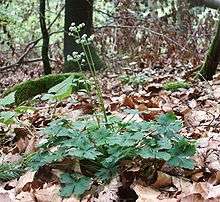Sanicula europaea
Sanicle amongst Celandine.
| Sanicle | |
|---|---|
 | |
| Scientific classification | |
| Kingdom: | Plantae |
| (unranked): | Angiosperms |
| (unranked): | Eudicots |
| (unranked): | Asterids |
| Order: | Apiales |
| Family: | Apiaceae |
| Genus: | Sanicula |
| Species: | S. europaea |
| Binomial name | |
| Sanicula europaea L. | |
Sanicula europaea (sanicle, wood sanicle) is a perennial plant of the family Apiaceae.
Description
Sanicula europea L. grows to 60 cm high and is glabrous with coarsely toothed leaves.[1] The pinkish flowers are borne in tight spherical umbels and are followed by bristly fruits which easily attach to clothing or animal fur and are thus easily distributed. The leaves are lobed and glossy, dark green.
Habitat
It is widespread in shady places[2] woodland across Europe.
Uses
Sanicula europaea roots have been used in the traditional Austrian medicine internally (as tea) or externally (as ointment) for treatment of disorders of the skin, respiratory tract, locomotor system, gastrointestinal tract, and infections.[3]
See also
References
- ↑ Clapham, A.R., Tutin, T.G. and Warburg, E.F. 1968. Excursion Flora of the British Isles. Cambridge University Press. ISBN 0 521 04656 4
- ↑ Webb, D,A., Parnell, J. and Doogue, D. 1996. An Irish Flora Dundalgan Press Ltd. Dundalk. ISBN 0-85221-131-7
- ↑ Vogl, Sylvia; Picker, Paolo; Mihaly-Bison, Judit; Fakhrudin, Nanang; Atanasov, Atanas G.; Heiss, Elke H.; Wawrosch, Christoph; Reznicek, Gottfried; Dirsch, Verena M.; Saukel, Johannes; Kopp, Brigitte (2013). "Ethnopharmacological in vitro studies on Austria's folk medicine—An unexplored lore in vitro anti-inflammatory activities of 71 Austrian traditional herbal drugs". Journal of Ethnopharmacology. 149 (3): 750–71. doi:10.1016/j.jep.2013.06.007. PMC 3791396
 . PMID 23770053.
. PMID 23770053.
| Wikimedia Commons has media related to Sanicle. |
This article is issued from Wikipedia - version of the 2/27/2016. The text is available under the Creative Commons Attribution/Share Alike but additional terms may apply for the media files.